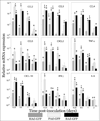Evaluation of innate immunity and vector toxicity following inoculation of bovine, porcine or human adenoviral vectors in a mouse model
- PMID: 20659505
- PMCID: PMC2945211
- DOI: 10.1016/j.virusres.2010.07.021
Evaluation of innate immunity and vector toxicity following inoculation of bovine, porcine or human adenoviral vectors in a mouse model
Abstract
Nonhuman adenovirus (Ad) vectors derived from bovine Ad serotype 3 (BAd3) or porcine Ad serotype 3 (PAd3) can circumvent pre-existing immunity against human Ad (HAd). We have previously reported differential transduction of human and nonhuman cells by these Ad vectors, and their distinct receptor usage and biodistribution. To compare the induction of innate immunity, vector toxicity and vector uptake by Kupffer cells (KCs) following intravenous administration of PAd3, BAd3, or HAd5 vectors in mice, we determined mRNA expression levels of proinflammatory chemokines and cytokines, and Toll-like receptors (TLRs) in the liver and spleen. Tissue toxicity of these vectors was assessed by comparing serum levels of liver-specific enzymes, histopathology and Kupffer cell (KC) depletion. Compared to the HAd5 vector, PAd3 and BAd3 vectors were more potent stimulators of innate immune responses as indicated by enhanced mRNA expression of TLRs and proinflammatory chemokines and cytokine genes. Histopathological changes in the liver were most pronounced in HAd5-inoculated mice while BAd3- or PAd3-inoculated mice revealed mild histologic changes that were confined to early time points. Inoculation with HAd5 or PAd3 vectors resulted in a significant (P<0.05) decline of the number of KCs in the liver. Together, these results extend our previous observations regarding distinct in vivo biology of nonhuman and human Ad vectors.
(c) 2010 Elsevier B.V. All rights reserved.
Figures






Similar articles
-
Comparative analysis of vector biodistribution, persistence and gene expression following intravenous delivery of bovine, porcine and human adenoviral vectors in a mouse model.Virology. 2009 Mar 30;386(1):44-54. doi: 10.1016/j.virol.2009.01.008. Epub 2009 Feb 10. Virology. 2009. PMID: 19211122 Free PMC article.
-
Circumvention of vector-specific neutralizing antibody response by alternating use of human and non-human adenoviruses: implications in gene therapy.Virology. 2000 Jun 20;272(1):159-67. doi: 10.1006/viro.2000.0350. Virology. 2000. PMID: 10873758
-
Comparative transduction efficiencies of human and nonhuman adenoviral vectors in human, murine, bovine, and porcine cells in culture.Biochem Biophys Res Commun. 2005 Feb 18;327(3):960-6. doi: 10.1016/j.bbrc.2004.12.099. Biochem Biophys Res Commun. 2005. PMID: 15649439
-
Current strategies and future directions for eluding adenoviral vector immunity.Curr Gene Ther. 2006 Apr;6(2):215-26. doi: 10.2174/156652306776359478. Curr Gene Ther. 2006. PMID: 16611043 Free PMC article. Review.
-
Adenoviral vector immunity: its implications and circumvention strategies.Curr Gene Ther. 2011 Aug;11(4):307-20. doi: 10.2174/156652311796150372. Curr Gene Ther. 2011. PMID: 21453277 Free PMC article. Review.
Cited by
-
Comparative Evaluation of the Vaccine Efficacies of Three Adenovirus-Based Vector Types in the Friend Retrovirus Infection Model.J Virol. 2019 Oct 15;93(21):e01155-19. doi: 10.1128/JVI.01155-19. Print 2019 Nov 1. J Virol. 2019. PMID: 31375593 Free PMC article.
-
Adenoviral vector-based platforms for developing effective vaccines to combat respiratory viral infections.Clin Transl Immunology. 2021 Oct 12;10(10):e1345. doi: 10.1002/cti2.1345. eCollection 2021. Clin Transl Immunology. 2021. PMID: 34667600 Free PMC article. Review.
-
EphrinA1-EphA2 interaction-mediated apoptosis and FMS-like tyrosine kinase 3 receptor ligand-induced immunotherapy inhibit tumor growth in a breast cancer mouse model.J Gene Med. 2012 Feb;14(2):77-89. doi: 10.1002/jgm.1649. J Gene Med. 2012. PMID: 22228563 Free PMC article.
-
Bovine Adenoviral Vector-Based Platform for Vaccine Development.Vaccines (Basel). 2025 May 3;13(5):494. doi: 10.3390/vaccines13050494. Vaccines (Basel). 2025. PMID: 40432106 Free PMC article. Review.
-
A porcine adenovirus with low human seroprevalence is a promising alternative vaccine vector to human adenovirus 5 in an H5N1 virus disease model.PLoS One. 2010 Dec 16;5(12):e15301. doi: 10.1371/journal.pone.0015301. PLoS One. 2010. PMID: 21179494 Free PMC article.
References
-
- Mouse Phenome Database. http://www.jax.org/phenome.
-
- Alemany R, Suzuki K, Curiel DT. Blood clearance rates of adenovirus type 5 in mice. J.Gen.Virol. 2000;81:2605–2609. - PubMed
-
- Appledorn DM, Kiang A, McBride A, Jiang H, Seregin S, Scott JM, Stringer R, Kousa Y, Hoban M, Frank MM, Amalfitano A. Wild-type adenoviruses from groups A-F evoke unique innate immune responses, of which HAd3 and SAd23 are partially complement dependent. Gene Ther. 2008a;15:885–901. - PubMed
-
- Appledorn DM, Patial S, McBride A, Godbehere S, van RN, Parameswaran N, Amalfitano A. Adenovirus vector-induced innate inflammatory mediators, MAPK signaling, as well as adaptive immune responses are dependent upon both TLR2 and TLR9 in vivo. J.Immunol. 2008b;181:2134–2144. - PubMed
-
- Bangari DS, Mittal SK. Porcine adenoviral vectors evade preexisting humoral immunity to adenoviruses and efficiently infect both human and murine cells in culture. Virus Res. 2004;105:127–136. - PubMed
Publication types
MeSH terms
Substances
Grants and funding
LinkOut - more resources
Full Text Sources
Medical

